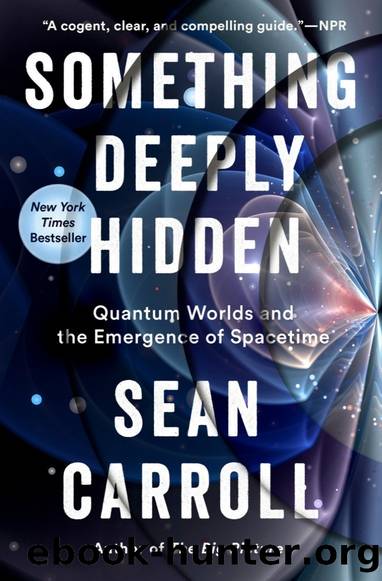Something Deeply Hidden: Quantum Worlds and the Emergence of Spacetime by Sean Carroll

Author:Sean Carroll [Carroll, Sean]
Language: eng
Format: epub
ISBN: 9781524743017
Google: U3n1DwAAQBAJ
Amazon: 1524743011
Barnesnoble: 1524743011
Goodreads: 44065062
Publisher: Penguin Publishing Group
Published: 2019-09-10T00:00:00+00:00
* * *
â â â
The virtue of Many-Worlds is in the simplicity of its basic formulation: there is a wave function that evolves according to the Schrödinger equation. All else is commentary. Some of that commentary, such as the split into systems and their environment, decoherence, and branching of the wave function, is extremely useful, and indeed indispensable to matching the crisp elegance of the underlying formalism to our messy experience of the world.
Whatever your feelings might be about Many-Worlds, its simplicity provides a good starting point for considering alternatives. If you remain profoundly skeptical that there are good answers to the problem of probability, or are simply repulsed by the idea of all those worlds out there, the task you face is to modify Many-Worlds in some way. Given that Many-Worlds is just âwave functions and the Schrödinger equation,â a few plausible ways forward immediately suggest themselves: altering the Schrödinger equation so that multiple worlds never develop, adding new variables in addition to the wave function, or reinterpreting the wave function as a statement about our knowledge rather than a direct description of reality. All of these roads have been enthusiastically walked down.
We turn first to the possibility of altering the Schrödinger equation. This approach would seem to be squarely in the comfort zone of most physicists; almost before any successful theory has been established, theorists ask how they could play around with the underlying equations to make it even better. Schrödinger himself originally hoped that his equation would describe waves that naturally localized into blobs that behaved like particles when viewed from far away. Perhaps some modification of his equation could achieve that ambition, and even provide a natural resolution to the measurement problem without permitting multiple worlds.
This is harder than it sounds. If we try the most obvious thing, adding new terms like Ψ2 to the equation, we tend to ruin important features of the theory, such as the total set of probabilities adding up to one. This kind of obstacle rarely deters physicists. Steven Weinberg, who developed the successful model that unified the electromagnetic and weak interactions in the Standard Model of particle physics, proposed a clever modification of the Schrödinger equation that manages to maintain the total probability over time. It comes at a cost, however; the simplest version of Weinbergâs theory allows you to send signals faster than light between entangled particles, as opposed to the no-signaling theorem of ordinary quantum mechanics. This flaw can be patched, but then something even weirder occurs: not only are there still other branches of the wave function, but you can actually send signals between them, building what physicist Joe Polchinski dubbed an âEverett phone.â Maybe thatâs a good thing, if you want to base your life choices on the outcome of a quantum measurement and then check in with your alternate selves to see which one turned out the best. But it doesnât seem to be the way that nature actually works. And it doesnât succeed in solving the measurement problem or getting rid of other worlds.
Download
This site does not store any files on its server. We only index and link to content provided by other sites. Please contact the content providers to delete copyright contents if any and email us, we'll remove relevant links or contents immediately.
The Complete Stick Figure Physics Tutorials by Allen Sarah(7282)
Secrets of Antigravity Propulsion: Tesla, UFOs, and Classified Aerospace Technology by Ph.D. Paul A. Laviolette(5266)
Thing Explainer by Randall Munroe(3861)
The River of Consciousness by Oliver Sacks(3514)
The Order of Time by Carlo Rovelli(3110)
How To by Randall Munroe(2991)
A Brief History of Time by Stephen Hawking(2927)
I Live in the Future & Here's How It Works by Nick Bilton(2914)
The Great Unknown by Marcus du Sautoy(2628)
What If?: Serious Scientific Answers to Absurd Hypothetical Questions by Randall Munroe(2605)
Midnight in Chernobyl by Adam Higginbotham(2451)
Blockchain: Ultimate Step By Step Guide To Understanding Blockchain Technology, Bitcoin Creation, and the future of Money (Novice to Expert) by Keizer Söze(2424)
Networks: An Introduction by Newman Mark(2318)
The Meaning of it All by Richard Feynman(2283)
Easy Electronics by Charles Platt(2265)
The Tao of Physics by Fritjof Capra(2215)
Midnight in Chernobyl: The Untold Story of the World's Greatest Nuclear Disaster by Adam Higginbotham(2145)
When by Daniel H Pink(2068)
Introducing Relativity by Bruce Bassett(2060)
